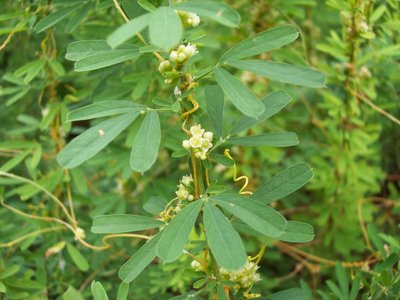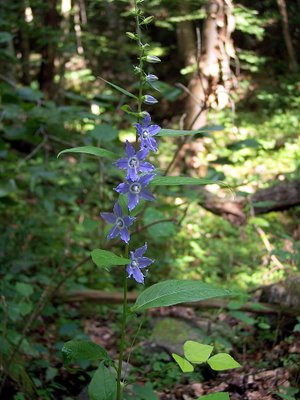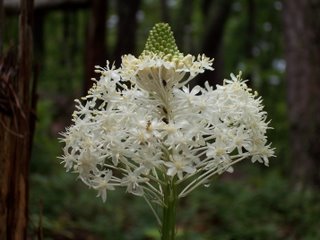
This snakedoctor was caught in a spider's web and still alive while I was taking this image. He wasn't trying to get away though. I did set him free in case you were wondering.

Consider the lilies of the field how they grow: they toil not, nor spin; but I say to you that not even Solomon in all his glory was arrayed as one of these.
 Mimulus alatus (Winged Monkeyflower) is a member of the plant family Scrophulariaceae (the snapdragon family). This family is usually characterized by bilabiate flowers that can be opened like snapdragons. Winged monkeyflower typically grows in open, wet woods and produces many flowers along its stem from the leaf axils. It flowers in mid- to late July. This photograph was taken in Jackson Co., AL in a natural seep along an old logging road. This deer resistant plant is native to Alabama and is reputed to be a food source for Buckeye butterflies.
Mimulus alatus (Winged Monkeyflower) is a member of the plant family Scrophulariaceae (the snapdragon family). This family is usually characterized by bilabiate flowers that can be opened like snapdragons. Winged monkeyflower typically grows in open, wet woods and produces many flowers along its stem from the leaf axils. It flowers in mid- to late July. This photograph was taken in Jackson Co., AL in a natural seep along an old logging road. This deer resistant plant is native to Alabama and is reputed to be a food source for Buckeye butterflies. 
 Adiantum capillus-veneris (Venus' Hair Fern) is a fern that is commonly found on wet, rocky outcroppings near streams and rivers. This delicate fern is widespread around the world and is found in the US across the southern states from coast to coast. The fan shaped leaves hang from blackish-purple stems and closely resemble Maidenhair Fern (Adiantum pedatum) leaves. Adiantum capillus-veneris literally means the hair (capillus) of venus (veneris) that is unwettable (adiantum.)
Adiantum capillus-veneris (Venus' Hair Fern) is a fern that is commonly found on wet, rocky outcroppings near streams and rivers. This delicate fern is widespread around the world and is found in the US across the southern states from coast to coast. The fan shaped leaves hang from blackish-purple stems and closely resemble Maidenhair Fern (Adiantum pedatum) leaves. Adiantum capillus-veneris literally means the hair (capillus) of venus (veneris) that is unwettable (adiantum.) 
 Wood Sage (Teucrium canadense) is better known as American Germander. This member of the mint family (Lamiaceae) has a foul smelling leaf when crushed, but was still used by early settlers for a variety of ailments. The flower structure is unusual having three sepals that stand up on top of the flower.
Wood Sage (Teucrium canadense) is better known as American Germander. This member of the mint family (Lamiaceae) has a foul smelling leaf when crushed, but was still used by early settlers for a variety of ailments. The flower structure is unusual having three sepals that stand up on top of the flower. 

 Dodder (Cuscuta gronovii?) in flower and parasitizing Chinese Lespedeza (Lespedeza cuneata.) You can decide for yourself which of the two plants is more evil. Dodder is native, but a nasty parasite. Chinese Lespedeza is a vigorous ivasive, but nitrifies the soil and does a great deal to prevent erosion. Either way, I liked this picture and thought I'd share it.
Dodder (Cuscuta gronovii?) in flower and parasitizing Chinese Lespedeza (Lespedeza cuneata.) You can decide for yourself which of the two plants is more evil. Dodder is native, but a nasty parasite. Chinese Lespedeza is a vigorous ivasive, but nitrifies the soil and does a great deal to prevent erosion. Either way, I liked this picture and thought I'd share it. 
 Dense Blazing Star (Liatris spicata) is a perennial, herbaceous plant that can reach hieghts of up to 7 feet tall. The leaves are linear in shape and are largest at the base of the plant tapering towards the top. Found in thin to open woods, usually in a moist area, Dense Blazing Star will have lavender blooms from early summer through fall.
Dense Blazing Star (Liatris spicata) is a perennial, herbaceous plant that can reach hieghts of up to 7 feet tall. The leaves are linear in shape and are largest at the base of the plant tapering towards the top. Found in thin to open woods, usually in a moist area, Dense Blazing Star will have lavender blooms from early summer through fall. 


 Tall Bellflower (Campanula americana) is blooming now in North Alabama. This picture was taken near Hytop, AL. It was growing in a wet area with mature trees shading it, but can also be found in open woods, thickets, and woodland borders. The star-shaped flowers grow on long branching spikes that can reach 6 feet tall. The blue flower has a distinctive long, curving style at its center and will bloom for over two weeks.
Tall Bellflower (Campanula americana) is blooming now in North Alabama. This picture was taken near Hytop, AL. It was growing in a wet area with mature trees shading it, but can also be found in open woods, thickets, and woodland borders. The star-shaped flowers grow on long branching spikes that can reach 6 feet tall. The blue flower has a distinctive long, curving style at its center and will bloom for over two weeks. 
 Ruellia caroliniana (Wild Petunia) is a beautiful native wildflower that is currently blooming its heart out. Other species (Ruellia purshiana) of this plant have already bloomed this year. This plant is in the Acanthaceae family which also hosts several other native plants to Alabama, including Justicia americana (American Water Willow).
Ruellia caroliniana (Wild Petunia) is a beautiful native wildflower that is currently blooming its heart out. Other species (Ruellia purshiana) of this plant have already bloomed this year. This plant is in the Acanthaceae family which also hosts several other native plants to Alabama, including Justicia americana (American Water Willow). 
 Hyla cinerea (Green Tree Frog) hanging out with Pontederia cordata (Pickerel Weed) in Historic Blakely State Park. Pickerel weed is a vigorous, deciduous, emergent marginal aquatic perennial that typically grows 2-4’ tall. It is native to quiet waters at stream and pond margins from Nova Scotia south to Florida and Alabama. In the wild, it is frequently seen growing in dense colonies. Glossy, narrow, arrowhead-shaped green leaves (to 10” long) have rounded cordate bases and rise well above the water surface. Tiny, tubular soft blue flowers are densely packed into erect, 3-6” long spikes atop flower stalks typically rising 1-2’ above the water surface. Plants flower freely from late May to October. Flowers give way to starchy seeds with distinctive toothed ridges. Flower spikes droop after bloom, releasing the distinctive seeds into the water. Seeds are edible off the plant or can be dried and added to granola cereals. Dragonflies and damselflies commonly lay their eggs on plant stems near the water surface.
Hyla cinerea (Green Tree Frog) hanging out with Pontederia cordata (Pickerel Weed) in Historic Blakely State Park. Pickerel weed is a vigorous, deciduous, emergent marginal aquatic perennial that typically grows 2-4’ tall. It is native to quiet waters at stream and pond margins from Nova Scotia south to Florida and Alabama. In the wild, it is frequently seen growing in dense colonies. Glossy, narrow, arrowhead-shaped green leaves (to 10” long) have rounded cordate bases and rise well above the water surface. Tiny, tubular soft blue flowers are densely packed into erect, 3-6” long spikes atop flower stalks typically rising 1-2’ above the water surface. Plants flower freely from late May to October. Flowers give way to starchy seeds with distinctive toothed ridges. Flower spikes droop after bloom, releasing the distinctive seeds into the water. Seeds are edible off the plant or can be dried and added to granola cereals. Dragonflies and damselflies commonly lay their eggs on plant stems near the water surface.
 Kalmia hirsuta (Hairy Wicky) is one of my new favorite names in botany. This shrub is one that is not common and was once state listed as threatened by Alabama. I love the common name of this plant. Hairy Wicky...why do I like it so much?? I do not know. Closely related to Kalmia latifolia (Moutain Laurel - see previous postings for image) a more common shrub in northern Alabama, this shrub is much less likely to be encountered and is typically only a coastal plain species.
Kalmia hirsuta (Hairy Wicky) is one of my new favorite names in botany. This shrub is one that is not common and was once state listed as threatened by Alabama. I love the common name of this plant. Hairy Wicky...why do I like it so much?? I do not know. Closely related to Kalmia latifolia (Moutain Laurel - see previous postings for image) a more common shrub in northern Alabama, this shrub is much less likely to be encountered and is typically only a coastal plain species.



 Tree-of-Heaven (Ailanthus altissima) is native to Asia, and began its journey west by being introduced to Europe in 1751 by a French Jesuit preist who brought it from Nanking, China to England. The first known specimen was brought into the United States a few decades later by William Hamilton, who planted this species in Philadelphia. People admired the beautiful foliage of these fast-growing trees, and for over a century have been planting it as an ornamental, although the leaves emit a foul-smelling odor.
Tree-of-Heaven (Ailanthus altissima) is native to Asia, and began its journey west by being introduced to Europe in 1751 by a French Jesuit preist who brought it from Nanking, China to England. The first known specimen was brought into the United States a few decades later by William Hamilton, who planted this species in Philadelphia. People admired the beautiful foliage of these fast-growing trees, and for over a century have been planting it as an ornamental, although the leaves emit a foul-smelling odor.


 This Carnivorous (insectivorous) plant consists of a small rosette of yellowish-green leaves with upturned margins. The flypaper method of capture is employed whereby the insect becomes mired down in the mucilage which covers the leaves. The margins may slowly enfold the animal over a period of time, after which, enzymes are released which begin the digestive process. Pinguicula lutea is a member of the Lentibulariaceae - Bladderwort family.
This Carnivorous (insectivorous) plant consists of a small rosette of yellowish-green leaves with upturned margins. The flypaper method of capture is employed whereby the insect becomes mired down in the mucilage which covers the leaves. The margins may slowly enfold the animal over a period of time, after which, enzymes are released which begin the digestive process. Pinguicula lutea is a member of the Lentibulariaceae - Bladderwort family.




 Amphiuma means
Amphiuma means